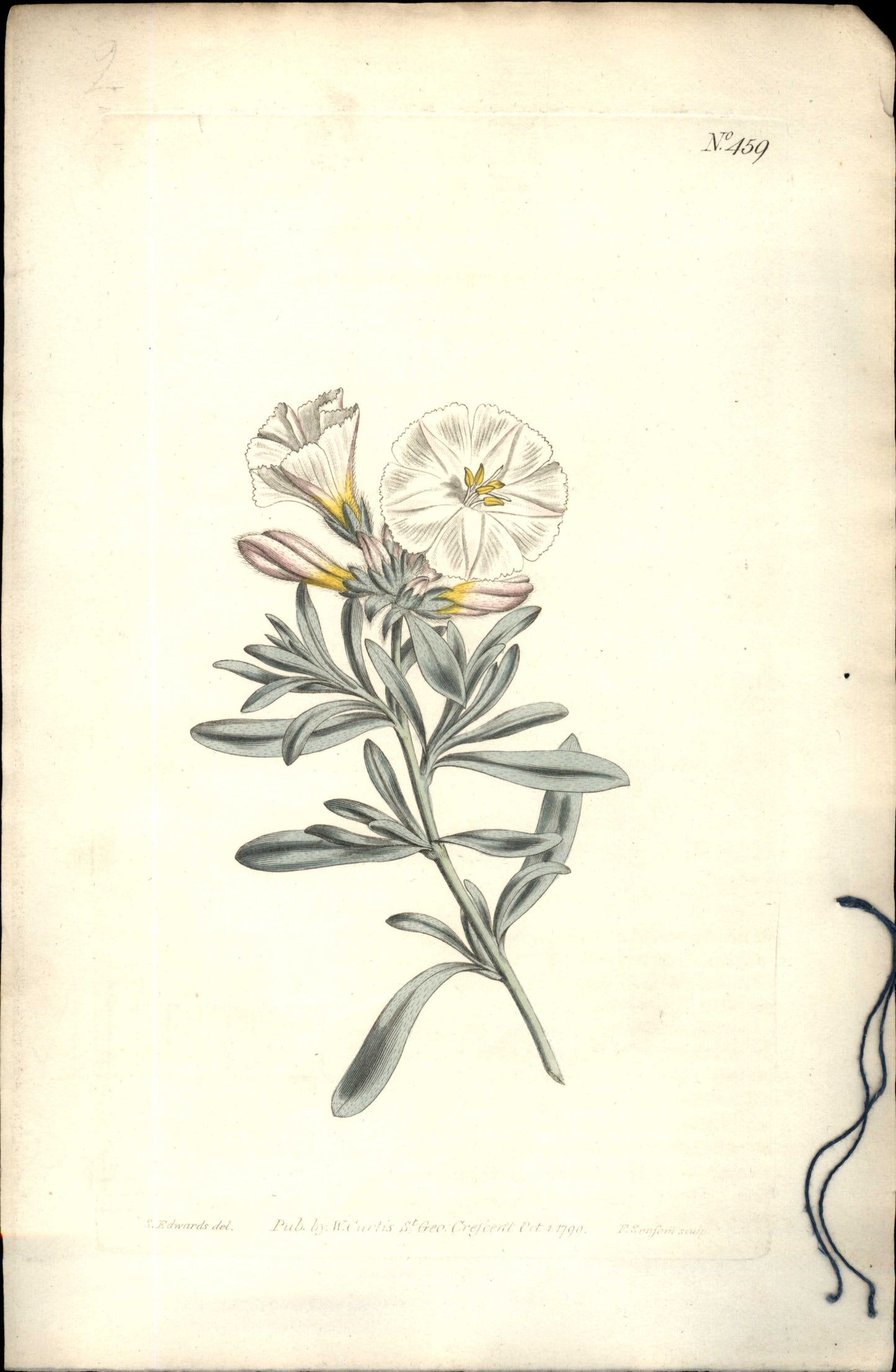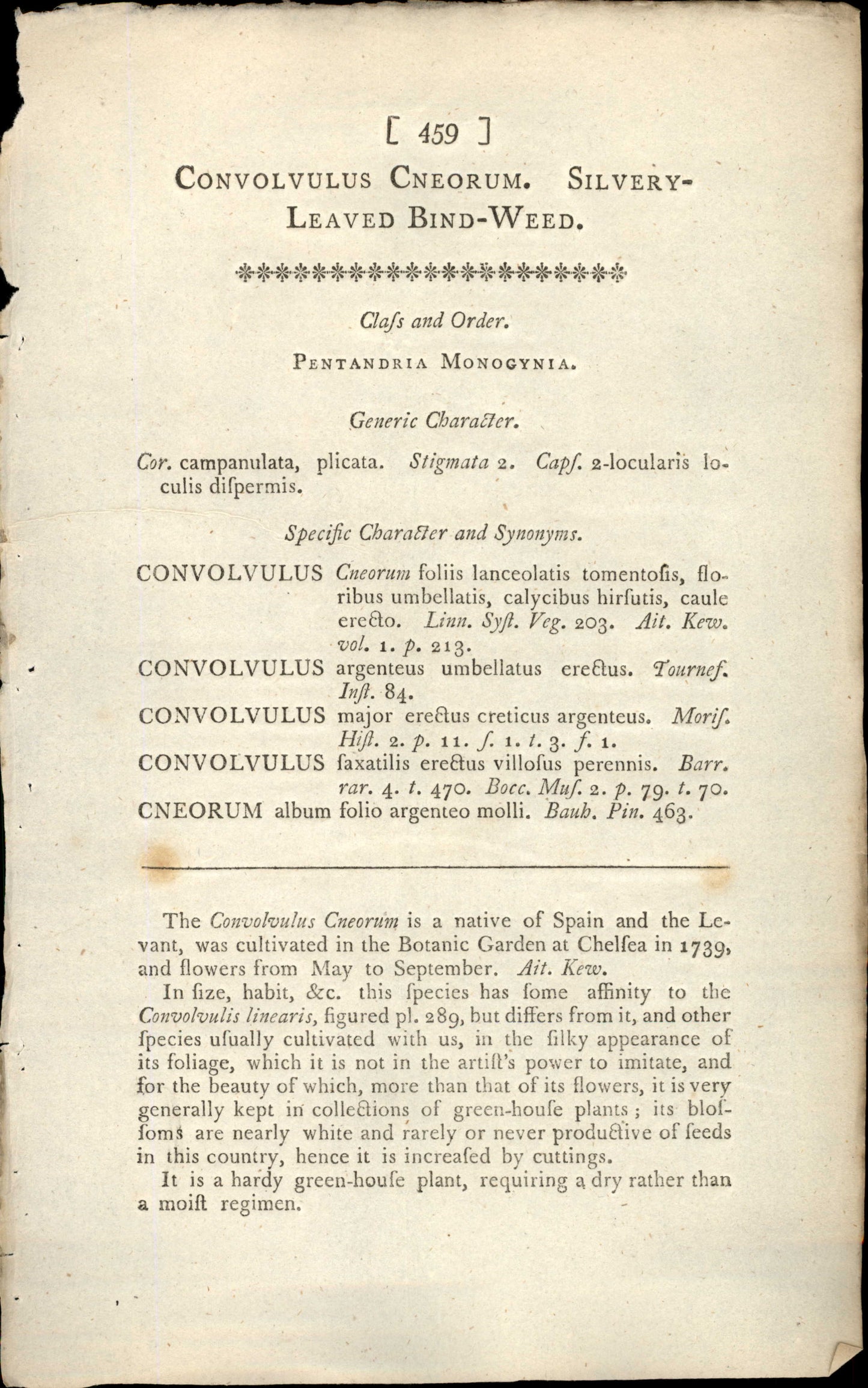Curtis Botanical Magazine
Plate 459 - Pentandria Monogynia
Plate 459 - Pentandria Monogynia
Couldn't load pickup availability
Plate 459
Classification: PENTANDRIA MONOGYNIA
Flowering Period: May - September
Publication Date: in 1739
Description:
Botanical Description
Convolvulus Cneorum is a native of Spain and the Le- vant, was cultivated in the Botanic Garden at Chelsea in 1739, and flowers from May to September. Ait. Kew. In fize, habit, &c. this species has some affinity to the Convolvulis linearis, figured pl. 289, but differs from it, and other species ufually cultivated with us, in the filky appearance of its foliage, which it is not in the artift's power to imitate, and for the beauty of which, more than that of its flowers, it is very generally kept in collections of green-houfe plants; its blof- foms are nearly white and rarely or never productive of feeds in this country, hence it is increafed by cuttings. It is a hardy green-houfe plant, requiring a dry rather than a moift regimen. --- CBM-ToList-459t.
Complete Botanical Text (Cleaned)
S.Edwards del.
N°459 Pub by W.Curtis &Geo: Crefcent Cet i 1799.
Fensom sculp [459 ] CONVOLVULUS CNEORUM.
SILVERY- ** LEAVED BIND-WEED. ************ Class and Order.
PENTANDRIA MONOGYNIA.
Generic Character.
Cor. campanulata, plicata. stigmata 2.
Capf. 2-locularis lo- culis dispermis. specific Character and synonyms.
CONVOLVULUS Cneorum soliis lanceolatis tomentofis, flo- ribus umbellatis, calycibus hirfutis, caule erecto.
Linn. syst.
Veg. 203.
Ait.
Kew. vol. 1. p. 213.
CONVOLVULUS argenteus umbellatus erectus.
Tournef.
Inft. 84.
CONVOLVULUS major erectus creticus argenteus.
Morif.
Hift. 2. p. 11. f. 1. t. 3. f. 1.
CONVOLVULUS faxatilis erectus villofus perennis.
Barr. rar. 4. t. 470.
Bocc.
Mus. 2. p. 79. t. 70.
CNEORUM album solio argenteo molli.
Bauh.
Pin. 463.
The Convolvulus Cneorum is a native of spain and the Le- vant, was cultivated in the Botanic Garden at Chelsea in 1739, and flowers from May to September.
Ait.
Kew.
In size, habit, &c. this species has some affinity to the Convolvulis linearis, figured pl. 289, but differs from it, and other species usually cultivated with us, in the silky appearance of its soliage, which it is not in the artift's power to imitate, and sor the beauty of which, more than that of its flowers, it is very generally kept in collections of green-houfe plants; its blof- soms are nearly white and rarely or never productive of seeds in this country, hence it is increafed by cuttings.
It is a hardy green-houfe plant, requiring a dry rather than a moift regimen
Raw OCR Text (Original)
S.Edwards del. N°459 Pub by W.Curtis &Geo: Crefcent Cet i 1799. Fensom sculp [459 ] CONVOLVULUS CNEORUM. SILVERY- ** LEAVED BIND-WEED. ************ Class and Order. PENTANDRIA MONOGYNIA. Generic Character. Cor. campanulata, plicata. stigmata 2. Capf. 2-locularis lo- culis dispermis. specific Character and synonyms. CONVOLVULUS Cneorum soliis lanceolatis tomentofis, flo- ribus umbellatis, calycibus hirfutis, caule erecto. Linn. syst. Veg. 203. Ait. Kew. vol. 1. p. 213. CONVOLVULUS argenteus umbellatus erectus. Tournef. Inft. 84. CONVOLVULUS major erectus creticus argenteus. Morif. Hift. 2. p. 11. f. 1. t. 3. f. 1. CONVOLVULUS faxatilis erectus villofus perennis. Barr. rar. 4. t. 470. Bocc. Mus. 2. p. 79. t. 70. CNEORUM album solio argenteo molli. Bauh. Pin. 463. The Convolvulus Cneorum is a native of spain and the Le- vant, was cultivated in the Botanic Garden at Chelsea in 1739, and flowers from May to September. Ait. Kew. In size, habit, &c. this species has some affinity to the Convolvulis linearis, figured pl. 289, but differs from it, and other species usually cultivated with us, in the silky appearance of its soliage, which it is not in the artift's power to imitate, and sor the beauty of which, more than that of its flowers, it is very generally kept in collections of green-houfe plants; its blof- soms are nearly white and rarely or never productive of seeds in this country, hence it is increafed by cuttings. It is a hardy green-houfe plant, requiring a dry rather than a moift regimen.
Original botanical print from Curtis's Botanical Magazine
Share





